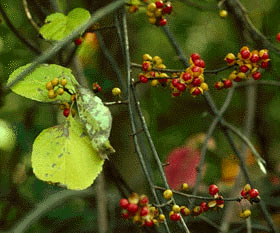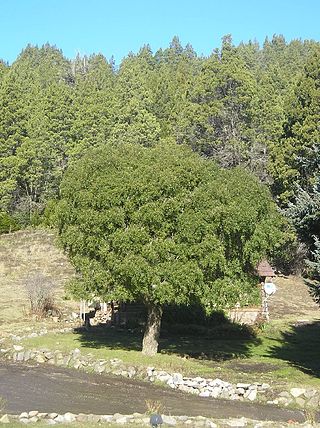
The Celastrales are an order of flowering plants found throughout the tropics and subtropics, with only a few species extending far into the temperate regions. The 1200 to 1350 species are in about 100 genera. All but seven of these genera are in the large family Celastraceae. Until recently, the composition of the order and its division into families varied greatly from one author to another.

The Celastraceae are a family of 97 genera and 1,350 species of herbs, vines, shrubs and small trees, belonging to the order Celastrales. The great majority of the genera are tropical, with only Celastrus, Euonymus and Maytenus widespread in temperate climates, and Parnassia (bog-stars) found in alpine and arctic climates.
Keetia is a genus of flowering plants in the family Rubiaceae. It consists of climbers or scrambling shrubs, rarely small trees.

Maytenus is a genus of flowering plants in the family Celastraceae. Members of the genus are distributed throughout Central and South America, Southeast Asia, Micronesia and Australasia, the Indian Ocean and Africa. They grow in a very wide variety of climates, from tropical to subpolar. The traditional circumscription of Maytenus is paraphyletic, so many species have been transferred to Denhamia, Gymnosporia, Monteverdia, and Tricerma.
Abraham Erasmus van Wyk, also known as Braam van Wyk is a South African plant taxonomist. He has been responsible for the training of a significant percentage of the active plant taxonomists in South Africa and has also produced the first electronic application (app) for the identification of trees in southern Africa.

Ehretia is a genus of flowering plants in the borage family, Boraginaceae. It contains about 50 species. The generic name honors German botanical illustrator Georg Dionysius Ehret (1708–1770).
Anthodon is a genus of flowering plants in the family Celastraceae. It comprises two species of large woody vines native to Central America and northern and Amazonian South America. They are scattered throughout most of the Neotropics, but are not common in any part of their range. They grow in wet forests from 100 m to 900 m in elevation. There is no known use of these vines by humans.

Apodytes is a genus of flowering plants in the family Metteniusaceae. It was formerly either unplaced as to family or placed in the family Icacinaceae. It consists of about 8 species of evergreen trees, from tropical northeastern Australia, New Caledonia, Africa and Asia. The exact number of species has been revised from 3 to 8, according to The Plant List.
Rolf Martin Theodor Dahlgren was a Swedish-Danish botanist and professor at the University of Copenhagen from 1973 to his death.

Cassine is a genus of trees, of the plant family Celastraceae.
Aphilopota phanerostigma is a species of moth of the family Geometridae first described by Louis Beethoven Prout in 1917. It is found in the Democratic Republic of the Congo, South Africa, Zimbabwe and Ethiopia.

Marie Prins is a South African botanist.

Tetradenia (gingerbush) is a genus of plants in the family Lamiaceae, first described in 1830. It is native to Africa, including Madagascar.
- Tetradenia bainesii(N.E.Br.) Phillipson & C.F.Steyn - Zimbabwe, Mozambique, Eswatini, KwaZulu-Natal
- Tetradenia barberae(N.E.Br.) Codd - Cape Province
- Tetradenia brevispicata(N.E.Br.) Codd - Zimbabwe, Namibia, Botswana, Transvaal
- Tetradenia clementianaPhillipson - Madagascar
- Tetradenia cordataPhillipson - Madagascar
- Tetradenia discolorPhillipson - Zambia, Zaire, Zimbabwe, Malawi, Tanzania
- Tetradenia falafaPhillipson - Madagascar
- Tetradenia fruticosaBenth. - Madagascar
- Tetradenia galpinii(N.E.Br.) Phillipson & C.F.Steyn - southeast Africa from Tanzania to Eswatini
- Tetradenia goudotiiBriq. - Madagascar
- Tetradenia herbacea Phillipson - Madagascar
- Tetradenia hildeanaPhillipson - Madagascar
- Tetradenia isaloensisPhillipson - Madagascar
- Tetradenia kaokoensisvan Jaarsv. & A.E.van Wyk - Namibia
- Tetradenia multiflora(Benth.) Phillipson - Ethiopia
- Tetradenia nervosaCodd - Madagascar
- Tetradenia riparia(Hochst.) Codd - southern Africa from Angola + Malawi to Eswatini
- Tetradenia tanganyikaePhillipson - Malawi, Tanzania, Zambia
- Tetradenia tuberosaT.J.Edwards - KwaZulu-Natal
- Tetradenia urticifolia(Baker) Phillipson - eastern + central Africa from Sudan + Eritrea south to Zaire and Tanzania

Putterlickia, variously called spikethorns, false spike thorns, mock spike thorns and bastard spike thorns, are a genus of flowering plants in the staff vine and bittersweet family Celastraceae, native to South Africa, Eswatini and Mozambique. Endophytic bacteria in their roots produce maytansine.
The anthophytes are a grouping of plant taxa bearing flower-like reproductive structures. They were formerly thought to be a clade comprising plants bearing flower-like structures. The group contained the angiosperms - the extant flowering plants, such as roses and grasses - as well as the Gnetales and the extinct Bennettitales.
Dewinteria is a monotypic genus of flowering plants belonging to the family Pedaliaceae. The only species is Dewinteria petrophila.









